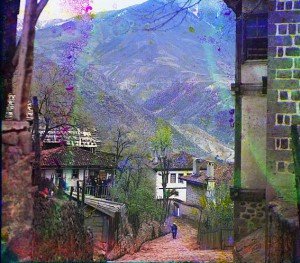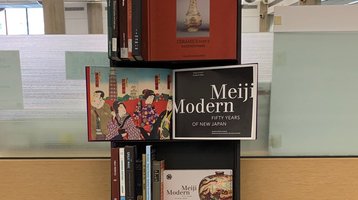The Caucasus: Land of Diverse Cultures
The title chosen for this mini-exhibit reflects one exceptional aspect of the Caucasus–the diversity of its peoples (more than 40 ethnic groups), languages (50+ languages from both small indigenous language families and from the wider Indo-European, Mongolic, Semitic and Turkic language families), religions (Islam, Christianity, Judaism, Buddhism), geography (mountains, glaciers, lowlands, seashore), history and culture. The exhibit could just have easily been entitled “Small Nations and Great Powers”, “Crossroads and Conflict”, “Shattering Empires”, all titles of recent books on the Caucasus. It is a small region of great contrasts and from time immemorial, of geopolitical significance to those larger nations which surround it—Russia to the north and Turkey and Iran to the south. For centuries the North Caucasus region, forming the borderland of European Russia, has represented the literal and symbolic frontier between Europe and Asia. But it is the South Caucasus region, comprised of the now independent countries of Armenia, Azerbaijan, and Georgia,that is the primary focus of this exhibit. The Caucasus has captured the imagination of travelers throughout the ages, as well as being of current strategic importance to the world’s powers. As one can see from even the briefest of historical chronologies, these have been countries involved in almost continuous conflict, war, forced migrations, massacres, ethnic cleansing, invasion, conquest and re-conquest, with borders that have shifted in response to each cataclysmic event. Nevertheless, each country has been able to nourish its language, literature, folklore and art, preserving its sense of ethnic and national identity (to paraphrase a local proverb–“There are more poets than mountains”).

As a true crossroads, the Caucasus plays an integral role in the emerging field of borderland studies (see journals such as Eurasia Border Review, The Journal of Borderland Studies), as well as Silk Road Studies (see the Central Asia-Caucasus Institute’s Silk Road Studies Program at Johns Hopkins). Likewise, in the last decade or so, the addition of the word Eurasian to many of our long-standing academic Slavic and East European organizations and institutions documents this new emphasis on the regions of the Caucasus and Central Asia; perhaps the most notable example of this is the official change in name of The American Association for the Advancement of Slavic Studies to The Association for Slavic, East European and Eurasian Studies (ASEEES).
This exhibit has been prepared to coincide with the University’s Center for East European, Russian and Eurasian Studies (CEERES) 2012-2013 lecture series “Connecting with the Caucasus“, which has brought together scholars from a variety of fields (Linguistics, History, Politics, Anthropology and Sociology, Literature/Music/Art) to revisit the histories, analyze the contemporary situations, encouraging the creation of new knowledge with regard to this area of considerable humanistic, social scientific, and strategic significance. The speaker series will set the stage for a 2014 CEERES conference on the Caucasus–a follow-up to its 2007 conference (The Caucasus: Directions and Disciplines).
The next lecture in the program will be:
Georgi Derluguian (NYU Abu Dhabi), speaking on “Guns, Maize, and Foreign Trade: The Origins of Democratic Polis in the Eighteenth-Century Caucasus”. (February 12, 2013, 5:30pm, Franke Institute for the Humanities)
The exhibit, located in the Second Floor Reading Room of Regenstein Library, will run through April 2013.


